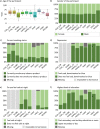Overview of retrospective data harmonisation in the MINDMAP project: process and results
- PMID: 33184054
- PMCID: PMC8053335
- DOI: 10.1136/jech-2020-214259
Overview of retrospective data harmonisation in the MINDMAP project: process and results
Abstract
Background: The MINDMAP project implemented a multinational data infrastructure to investigate the direct and interactive effects of urban environments and individual determinants of mental well-being and cognitive function in ageing populations. Using a rigorous process involving multiple teams of experts, longitudinal data from six cohort studies were harmonised to serve MINDMAP objectives. This article documents the retrospective data harmonisation process achieved based on the Maelstrom Research approach and provides a descriptive analysis of the harmonised data generated.
Methods: A list of core variables (the DataSchema) to be generated across cohorts was first defined, and the potential for cohort-specific data sets to generate the DataSchema variables was assessed. Where relevant, algorithms were developed to process cohort-specific data into DataSchema format, and information to be provided to data users was documented. Procedures and harmonisation decisions were thoroughly documented.
Results: The MINDMAP DataSchema (v2.0, April 2020) comprised a total of 2841 variables (993 on individual determinants and outcomes, 1848 on environmental exposures) distributed across up to seven data collection events. The harmonised data set included 220 621 participants from six cohorts (10 subpopulations). Harmonisation potential, participant distributions and missing values varied across data sets and variable domains.
Conclusion: The MINDMAP project implemented a collaborative and transparent process to generate a rich integrated data set for research in ageing, mental well-being and the urban environment. The harmonised data set supports a range of research activities and will continue to be updated to serve ongoing and future MINDMAP research needs.
Keywords: Cohort studies; epidemiology; longitudinal studies; methodology.
© Author(s) (or their employer(s)) 2021. Re-use permitted under CC BY. Published by BMJ.
Conflict of interest statement
Competing interests: None declared.
Figures


References
Publication types
MeSH terms
Grants and funding
LinkOut - more resources
Full Text Sources
Medical
Miscellaneous
